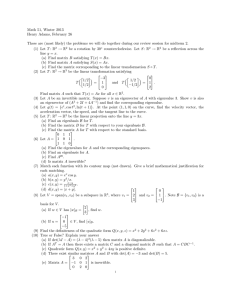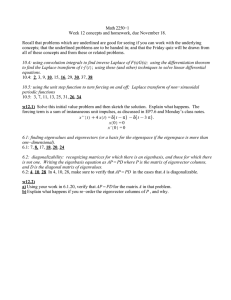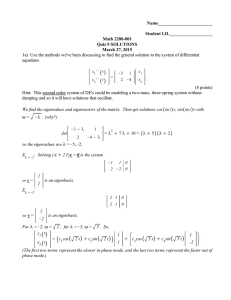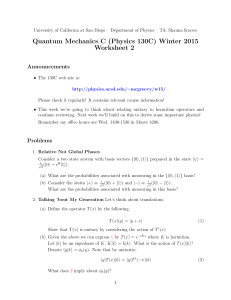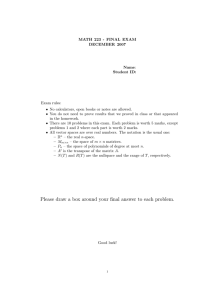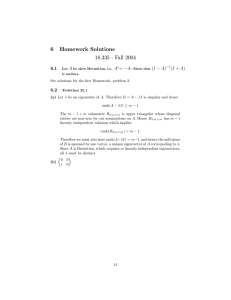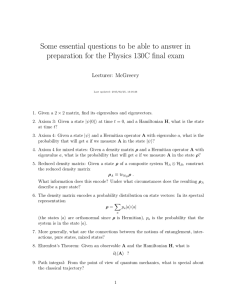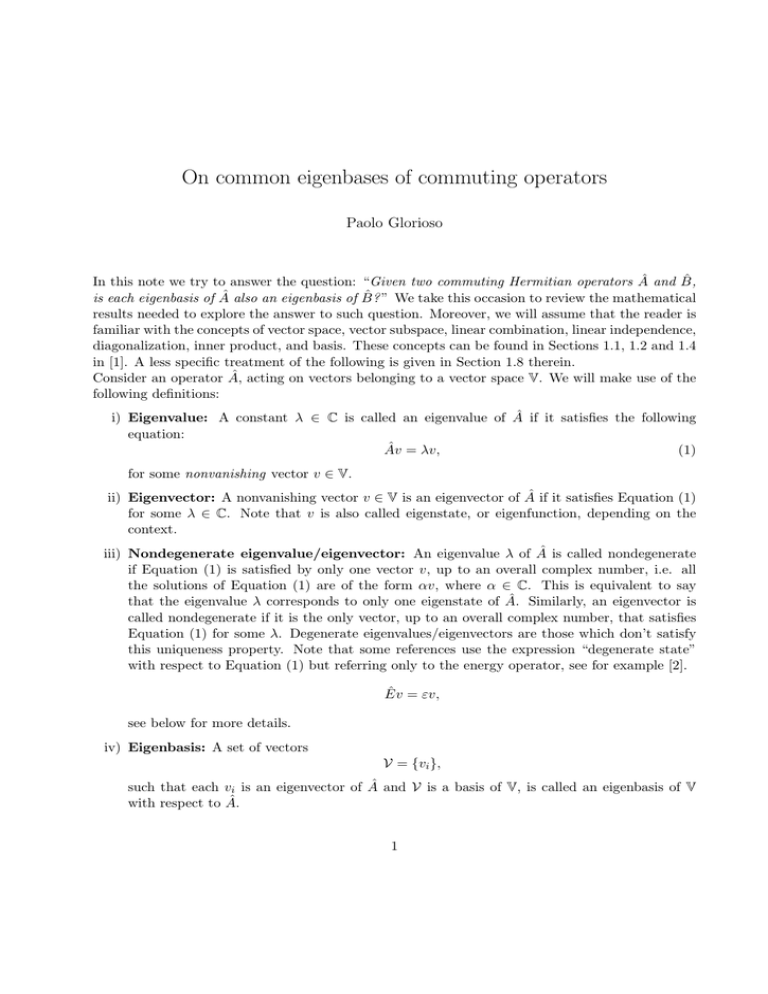
On common eigenbases of commuting operators
Paolo Glorioso
ˆ
In this note we try to answer the question: “Given two commuting Hermitian operators Aˆ and B,
ˆ ” We take this occasion to review the mathematical
is each eigenbasis of Aˆ also an eigenbasis of B?
results needed to explore the answer to such question. Moreover, we will assume that the reader is
familiar with the concepts of vector space, vector subspace, linear combination, linear independence,
diagonalization, inner product, and basis. These concepts can be found in Sections 1.1, 1.2 and 1.4
in [1]. A less specific treatment of the following is given in Section 1.8 therein.
ˆ acting on vectors belonging to a vector space V. We will make use of the
Consider an operator A,
following definitions:
i) Eigenvalue: A constant λ ∈ C is called an eigenvalue of Aˆ if it satisfies the following
equation:
Âv = λv,
(1)
for some nonvanishing vector v ∈ V.
ii) Eigenvector: A nonvanishing vector v ∈ V is an eigenvector of Aˆ if it satisfies Equation (1)
for some λ ∈ C. Note that v is also called eigenstate, or eigenfunction, depending on the
context.
iii) Nondegenerate eigenvalue/eigenvector: An eigenvalue λ of Aˆ is called nondegenerate
if Equation (1) is satisfied by only one vector v, up to an overall complex number, i.e. all
the solutions of Equation (1) are of the form αv, where α ∈ C. This is equivalent to say
ˆ Similarly, an eigenvector is
that the eigenvalue λ corresponds to only one eigenstate of A.
called nondegenerate if it is the only vector, up to an overall complex number, that satisfies
Equation (1) for some λ. Degenerate eigenvalues/eigenvectors are those which don’t satisfy
this uniqueness property. Note that some references use the expression “degenerate state”
with respect to Equation (1) but referring only to the energy operator, see for example [2].
Êv = εv,
see below for more details.
iv) Eigenbasis: A set of vectors
V = {vi },
such that each vi is an eigenvector of Aˆ and V is a basis of V, is called an eigenbasis of V
ˆ
with respect to A.
1
In this note we will refer to Hermitian operators, where Aˆ is Hermitian if, for any u, v ∈ V,
ˆ = (Au,
ˆ v),
(u, Av)
and (u, v) is the scalar product in V. There are two reasons why we consider Hermitian operators.
First, because in Quantum Mechanics all observables are postulated to be Hermitian.1 Second,
because Hermitian operators are diagonalizable, i.e. they admit a basis in which they have a
diagonal form, which is then an eigenbasis. See Theorem 10 in Chapter 1 of [1] for this point.
Proposition 1. Let Aˆ be a Hermitian operator with only nondegenerate eigenvalues, and V = {vi }
ˆ Then V is obtained from W by permutations and multiplications
and W = {wi } two eigenbases of A.
by complex numbers of the eigenvectors of W, i.e., for each vi ∈ V, there is wj ∈ W and α ∈ C
such that
vi = αwj .
In other words, V and W contain the same eigenstates.
Proof. Let λi and µi be the eigenvalues of vi and wi , respectively, i.e.
ˆ i = λ i vi ,
Av
ˆ i = µ i wi .
Aw
(2)
Since W is a basis, we can write any vi ∈ V as a linear combination of the wi ’s,
X
vi =
αj wj ,
(3)
j
where αj ∈ C. Then,
ˆ i = Aˆ
λi vi = Av
X
αj wj =
j
X
ˆ j=
αj Aw
X
α j µ j wj .
j
j
ˆ Comparing the first and the last members of the above Equation
where we used the linearity of A.
with Equation (3), we get
X
X
X
λ i α j wj =
µj αj wj =⇒
(µj − λi ) αj wj = 0,
j
j
j
and using the fact that the wj ’s are linearly independent, we obtain,
(µj − λi ) αj = 0.
This is a set of equations, labelled by j. Each of them has two solutions: either αj = 0, or µj = λi .
Since by hypothesis, the µj ’s are all different from each other, being nondegenerate eigenvalues,
only one of the above set of equations can satisfy µj = λi . Thus all αj ’s but one are zero, and we
obtain, from Equation (3),
vi = αj wj ,
1
Recall that this is implied by the requirement of having real eigenvalues.
2
for one value of j. This tells us that each vector of V is also contained in W, up to an overall
complex number, which in the above Equation is given by αj . Of course, we can also revert the
whole reasoning and show that each vector of W is contained in V. Therefore we can say that the
two eigenbases are the same, up to permutations and multiplications by complex numbers of their
vectors, and we are done.
ˆ are Hermitian operators with vanishing commutator, i.e.
Proposition 2. Suppose that Aˆ and B
ˆ B]
ˆ = 0.
[A,
ˆ share a common eigenbasis.
Then Aˆ and B
ˆ V = {vi }, with λi the eigenvalue associated to vi . Then, for
Proof. Consider an eigenbasis of A,
any vi ,
ˆ ˆ i = BAv
ˆ ˆ i = λi Bv
ˆ i,
ABv
(4)
ˆ i 6= 0, Bv
ˆ i is an eigenvector of Aˆ associated to the same eigenvalue as vi , λi . We have two
i.e., if Bv
cases to consider:
ˆ i can differ from vi only by a constant factor, or
• λi nondegenerate: Bv
B̂vi = µi vi ,
ˆ with eigenvalue µi .
and thus vi is also an eigenvector of B,
• λi degenerate: in this case there are more vectors associated to λi , which we denote by
ˆ j is still an eigenvector of A,
ˆ
wj , j = 1, . . . , N , where N is the degeneracy of λi . Since Bw
ˆ
we can write it as a linear combination of the wj ’s. For this reason, the operator B can be
ˆ is Hermitian, it is
seen as acting “internally” in the subspace spanned by the wj ’s. Since B
Hermitian in particular in this subspace. Indeed, for any u1 , u2 belonging to such subspace,
ˆ 2 ) = (Bu
ˆ 1 , u2 ),
(u1 , Bu
just because u1 , u2 belong also to the “big” vector space V.
ˆ is Hermitian in this subspace we can diagonalize it, or in other words we can
Now, since B
ˆ which span this subspace, and we call them w0 . These w0
choose a basis of eigenvectors of B
j
j
ˆ and thus the Proposition is proved.
are still eigenvectors of A,
To understand better the last proof, we can view
by the following picture:
ˆ 1)
(v1 , Bv
(v , Bv
B̂ = 2 ˆ 1 )
..
.
3
ˆ as an “infinite matrix”, in the sense explained
B
ˆ 2) · · ·
(v1 , Bv
ˆ 2 ) · · · ,
(v2 , Bv
..
..
.
.
ˆ is represented. If we view B
ˆ in the
where the vi ’s belong to the basis with respect to which B
eigenbasis V introduced at the beginning of the proof, we have
B1
B2
,
(5)
B̂ =
B3
..
.
ˆ on the subspaces similar to
where each block Bi is a submatrix representing the internal action of B
ˆ and if λi is nondegenerate
the one spanned by the wj ’s. Each block refers to an eigenvalue λi of A,
the block will be just a 1 × 1 matrix. If λi is degenerate with degeneracy N then the block will be
N × N . What we did in the degenerate case of the proof was just to show that the corresponding
block Bi is a Hermitian matrix, and thus diagonalizable.
ˆ share a common eigenbasis, then their commutator is
Finally, note that if we know that Aˆ and B
zero. Indeed, sharing a common eigenbasis means that in such basis they are both represented as
diagonal operators, and thus they commute. This consideration allows us to state a more powerful
statement than the above Preposition:
ˆ be two Hermitian operators. Then the following two statements are
Proposition 3. Let Aˆ and B
equivalent:
ˆ possess a common eigenbasis.
i) Aˆ and B
ˆ commute.
ii) Aˆ and B
Aimed of the mathematical results we have found, we shall now answer the following question:
ˆ is each eigenbasis of Aˆ also an
Given two commuting Hermitian operators Aˆ and B,
ˆ
eigenbasis of B?
ˆ have only nondegenerate
The short answer is: it depends. Consider the case where both Aˆ and B
eigenvalues. Then, by virtue of Proposition 1 and 2, each eigenbasis of Aˆ is also an eigenbasis of
ˆ Indeed, by Proposition 2 we can consider a common eigenbasis of Aˆ and B,
ˆ which we denote
B.
by V . By Proposition 1 we know that we would exhaust all the eigenbases of Aˆ by permuting and
ˆ Thus, in
multiplying by complex numbers the vectors of V, and the same for the eigenbases of B.
this case, the answer to the above question is YES. In all the other cases, the answer is NO.
ˆ
Consider e.g. the case where Aˆ has some degenerate eigenvalues. Then, in some eigenbasis of A,
B̂ would look like in Equation (5), which is not in diagonal form if some of the blocks Bi are
nondiagonal. For a neat example, we can consider the following matrices:
3
1
A = 2 ,
B=
1 2i ,
2
−2i 1
note that [A, B] = 0, essentially because the 2 × 2 lower diagonal block of A is a scalar matrix,2 and
thus it must commute with the corresponding lower diagonal block of B. Moreover, B is Hermitian,
2
A scalar matrix is a matrix proportional to the identity.
4
and then diagonalizable. Note that A and B are represented in terms of an eigenbasis of A, and
that 2 is a degenerate eigenvalue of A. We denote this eigenbasis by V = {e1 , e2 , e3 }, where
1
0
0
e1 = 0 ,
e2 = 1 ,
e3 = 0 .
0
0
1
Following the proof of Proposition 2, we only need to find two linear combinations of e2 , e3 such
that the lower block of B assumes a diagonal form. Working out the standard diagonalization
procedure, we find the common eigenbasis W = {e1 , v2 , v3 }, where
1
v3 = √ (e2 − ie3 ),
2
1
v2 = √ (e2 + ie3 ),
2
and the above matrices assume the following form:
1
3
A = 2 ,
B = −1 .
2
3
For a more physical example, consider the hydrogen atom. The energy eigenstates are commonly
labelled by
|n, `, mi,
(6)
ˆ 2 , and m is the label associated to L
ˆz
where n is the energy level, ` is the label associated to L
through
L̂z ψ = ~mψ.
ˆ L
ˆ 2 and L
ˆ z are all diagonal. Using the fact that the states (6) are degenerate, we
In this basis, E,
ˆ z is nondiagonal. One example is
want to construct a new basis where L
V = {|n, `, si},
where
s
X
1
|n, `, mi,
|n, `, si = √
` + s + 1 m=−`
ˆ and L
ˆ 2 , but they are not
and where s = −`, . . . , `. Clearly, V is a complete set of eigenstates of E
ˆ z , indeed
eigenstates of L
s
s
X
X
1
1
ˆm|n, `, mi,
L̂z |n, `, si = √
L̂z |n, `, mi = √
~
` + s + 1 m=−`
` + s + 1 m=−`
which clearly doesn’t correspond to Equation (1). Another simple construction we can make with
the hydrogen atom is the following. Consider, instead of (6), the basis given by the eigenvectors of
ˆ L
ˆ 2 , and L
ˆ x , instead of L
ˆ z , and denote it by
E,
W = {|n, `, mx i}.
Thus we have that
L̂x |n, `, mx i = ~mx |n, `, mx i.
5
(7)
ˆ z will not be diagonal in this basis, indeed suppose that, for all mx , there exist αmx
However, L
such that
L̂z |n, `, mx i = αmx |n, `, mx i.
Then, on any eigenstate of the form (7),
ˆ y |n, `, mx i = [L
ˆz, L
ˆ x ]|n, `, mx i = [~m, αmx ]|n, `, mx i = 0,
iL
ˆ z , but it keeps being an eigenbasis
which we know to be false. Therefore W is not an eigenbasis for L
2
ˆ
ˆ
ˆ z assumes the following matrix
for E and L . In the basis given by the states (6), the operator L
form for the first 4 eigenstates:
0
−1
0
ˆ
,
Lz = ~
1
..
.
whereas, in the basis (7),
0
~
ˆ
√
Lz =
2
0 −1 0
−1 0 −1
0 −1 0
..
.
.
References
[1] R. Shankar, Principles of Quantum Mechanics (Kluwer, 1994).
[2] D.J. Griffiths, Introduction to Quantum Mechanics (Pearson Prentice Hall, 2005).
6
MIT OpenCourseWare
http://ocw.mit.edu
8.04 Quantum Physics I
Spring
For information about citing these materials or our Terms of Use, visit: http://ocw.mit.edu/terms.

